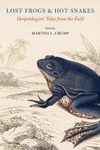Indochina (Laos, Cambodia, and Vietnam) houses over 600 species of amphibians and reptiles, roughly a quarter of which has been described within the last 15 years. Herein, we undertake the first biogeographic synthesis of the regional herpetofauna since the first half of the 20th century. We review the literature to measure and map species richness and endemism, the contributions of regional faunas, and ecological characteristics of Indochina's amphibians (Anura, Caudata), and reptiles (Serpentes, Sauria, Testudines, Crocodylia). Dividing Indochina into 19 subregions defined by topography and geology, we estimate the similarity among the regional faunas and appraise the effects of area and survey effort on these comparative analyses.
Variation in species composition is broadly correlated with topography, habitat complexity, and proximity to regions outside Indochina. Indochina's herpetofauna is dominated (in decreasing order) by endemic species, widely distributed species, a South China fauna, and a biota centered in Thailand and Myanmar. Species richness is highest in amphibians and snakes, and peaks in upland forests. Endemism, highest among amphibians and lizards, also peaks in forests of the region's northern uplands and Annamite Range. Endemic species occupy a narrower range of habitats than nonendemics. Patterns of richness and endemism are partially explained by ecological constraints: amphibians and lizards are more restricted to forests than snakes, turtles, and crocodiles; amphibians are more restricted to uplands, turtles to lowlands.
We also assess biogeography in the context of Indochina's geology, climate, and land cover. In northern Indochina, the Red River either acts as or coincides with an apparent dispersal barrier. Herpetofauna in northeastern upland areas are closely allied with fauna of southeastern China. In southern Indochina there is little evidence that the Mekong River represents a biogeographic barrier to the regional herpetofauna. The Annamite Range is composed of at least three distinct units and its elevated species richness and endemism are also noted in adjacent lowlands. Contribution of subtropical biota to Indochina's fauna is significantly greater than that of tropical biota and there is little other evidence for intermixing at intermediate latitudes.
Our results have implications for biogeography and conservation efforts, although they must be viewed in the context of rapidly evolving systematic knowledge of the region's amphibians and reptiles. Future survey efforts, and the phylogenetic analyses that come from them, are essential for supporting regional conservation efforts, as they will better resolve the known patterns of amphibian and reptile richness and endemism.










































